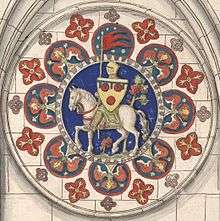Peter of Courtenay, Lord of Conches
Peter of Courtenay (French: Pierre de Courtenay (c. 1218 – 1249 or 1250 in Egypt) was a French knight and a member of the Capetian House of Courtenay, a cadet line of the royal House of Capet. From 1239 until his death, he was the ruling Lord of Conches-en-Ouche and Mehun-sur-Yèvre.
Peter of Courtenay, Lord of Conches | |
|---|---|
 Pierre of Courtenay, in a 13th century stained glass window in the Chartres Cathedral | |
| Born | c. 1218 |
| Died | 1249 or 1250 Egypt, probably Damietta or Al Mansourah |
| Noble family | Capetian House of Courtenay |
| Spouse(s) | Pétronille of Joigny |
| Issue | |
| Father | Robert of Courtenay |
| Mother | Matilda of Mehun |
Life
Peter was the eldest of five sons of Robert of Courtenay, Lord of Champignelles († 1239), and his wife Matilda of Mehun. From his parents he inherited the castle of Conches and Mehun. On 25 August 1248, he sailed with his cousin, King Louis IX of France, from Aigues-Mortes to Egypt to fight the Seventh Crusade, during which he died.
Most historians think he died during the battle for the city of Al Mansurah on 8 February 1250. On that day, Count Robert I of Artois led a vanguard of Crusaders in a spontaneous attack on the city. The vanguard was caught in a trap set by the defending Mamluks and all attackers were killed. However, the chronicler Jean de Joinville maintains Peter of Courtenay died on an earlier date. After the conquest of the Egytion port city of Damietta in June 1249, a large part of the crusader army camped outside the city wall, until they were ready to march to Al Mansurah in the autumn. The Sultan of Egypt offered a reward of one gold solidus for the head of each crusader. During the night, Saracens would sneak into the Crusader camp, kill sleeping Crusaders in their tents, and steal their severed heads. According to Joinville, Peter of Courtenay was the victim of one such attack.[1] However, Joinville may be mistaken. One should consider that he wrote his chronicle decades after the fact, and that Peter de Courtenay is mentioned twice later in the chronicle, in connection with the Battle of Al Mansurah.[2][3]
Marriage and issue
Peter was married to Pétronille (d.1289),[4] a daughter of Gaucher of Joigny and Amicie de Montfort. They had one child:
- Amicie (d. 1275 in Rome; buried in St. Peter's Basilica), Lady suo jure of Conches and Mehun, married in 1262 to Count Robert II of Artois (d. 1302).[5]
Pétronille remarried in 1252 to Henry II de Sully (d. 1269).
Footnotes
- Jean de Joinville: Chronicle, part II, §7, ed. by Ethel Wedgwood, 1906
- Jean de Joinville: Chronicle, , part II, §9-10, ed. by Ethel Wedgwood, 1906
- It is possible that Joinville confused Peter with his cousin Guillaume de Courtenay, Lord of Yerre, who also participated in the Seventh Crusade, and survived (see Histoire généalogique de la maison de France, p. 517)
- Jean Dunbabin, The French in the Kingdom of Sicily, 1266-1305, (Cambridge Press, ), xiii
- Jean Dunbabin, The French in the Kingdom of Sicily, 1266-1305, (Cambridge Press, ), xiii
Peter of Courtenay, Lord of Conches Born: c. 1218 Died: 1249 or 1250 | ||
| Preceded by Robert I |
Lord of Conches-en-Ouche 1239-1250 |
Succeeded by Robert II jure uxoris |
| Lord of Mehun-sur-Yèvre 1239-1250 | ||